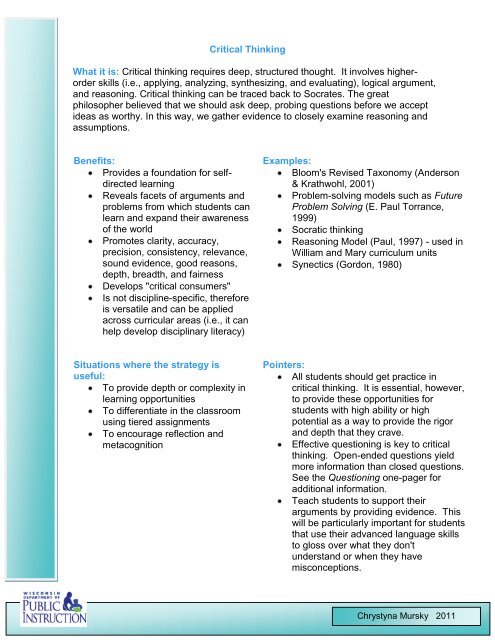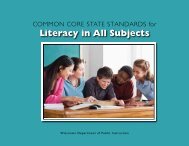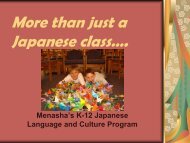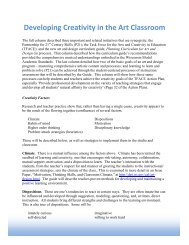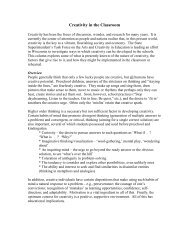Critical Thinking What it is: Critical thinking requires deep, structured ...
Critical Thinking What it is: Critical thinking requires deep, structured ...
Critical Thinking What it is: Critical thinking requires deep, structured ...
Create successful ePaper yourself
Turn your PDF publications into a flip-book with our unique Google optimized e-Paper software.
<strong>Cr<strong>it</strong>ical</strong> <strong>Thinking</strong><br />
<strong>What</strong> <strong>it</strong> <strong>is</strong>: <strong>Cr<strong>it</strong>ical</strong> <strong>thinking</strong> <strong>requires</strong> <strong>deep</strong>, <strong>structured</strong> thought. It involves higherorder<br />
skills (i.e., applying, analyzing, synthesizing, and evaluating), logical argument,<br />
and reasoning. <strong>Cr<strong>it</strong>ical</strong> <strong>thinking</strong> can be traced back to Socrates. The great<br />
philosopher believed that we should ask <strong>deep</strong>, probing questions before we accept<br />
ideas as worthy. In th<strong>is</strong> way, we gather evidence to closely examine reasoning and<br />
assumptions.<br />
Benef<strong>it</strong>s:<br />
Provides a foundation for selfdirected<br />
learning<br />
Reveals facets of arguments and<br />
problems from which students can<br />
learn and expand their awareness<br />
of the world<br />
Promotes clar<strong>it</strong>y, accuracy,<br />
prec<strong>is</strong>ion, cons<strong>is</strong>tency, relevance,<br />
sound evidence, good reasons,<br />
depth, breadth, and fairness<br />
Develops "cr<strong>it</strong>ical consumers"<br />
Is not d<strong>is</strong>cipline-specific, therefore<br />
<strong>is</strong> versatile and can be applied<br />
across curricular areas (i.e., <strong>it</strong> can<br />
help develop d<strong>is</strong>ciplinary l<strong>it</strong>eracy)<br />
Examples:<br />
Bloom's Rev<strong>is</strong>ed Taxonomy (Anderson<br />
& Krathwohl, 2001)<br />
Problem-solving models such as Future<br />
Problem Solving (E. Paul Torrance,<br />
1999)<br />
Socratic <strong>thinking</strong><br />
Reasoning Model (Paul, 1997) - used in<br />
William and Mary curriculum un<strong>it</strong>s<br />
Synectics (Gordon, 1980)<br />
S<strong>it</strong>uations where the strategy <strong>is</strong><br />
useful:<br />
To provide depth or complex<strong>it</strong>y in<br />
learning opportun<strong>it</strong>ies<br />
To differentiate in the classroom<br />
using tiered assignments<br />
To encourage reflection and<br />
metacogn<strong>it</strong>ion<br />
Pointers:<br />
All students should get practice in<br />
cr<strong>it</strong>ical <strong>thinking</strong>. It <strong>is</strong> essential, however,<br />
to provide these opportun<strong>it</strong>ies for<br />
students w<strong>it</strong>h high abil<strong>it</strong>y or high<br />
potential as a way to provide the rigor<br />
and depth that they crave.<br />
Effective questioning <strong>is</strong> key to cr<strong>it</strong>ical<br />
<strong>thinking</strong>. Open-ended questions yield<br />
more information than closed questions.<br />
See the Questioning one-pager for<br />
add<strong>it</strong>ional information.<br />
Teach students to support their<br />
arguments by providing evidence. Th<strong>is</strong><br />
will be particularly important for students<br />
that use their advanced language skills<br />
to gloss over what they don't<br />
understand or when they have<br />
m<strong>is</strong>conceptions.<br />
Chrystyna Mursky 2011
References/Resources<br />
Anderson, L. W., and Krathwohl, D. R., (Eds.). (2001). A taxonomy for learning,<br />
teaching and assessing: A rev<strong>is</strong>ion of Bloom's Taxonomy of educational<br />
objectives: Complete ed<strong>it</strong>ion. New York: Longman.<br />
Boswell, C. and Carlile, V.D. (2010). RTI for the gifted student. Hawthorne, NJ:<br />
Educational Impressions.<br />
Future Problem Solving webs<strong>it</strong>e. http://www.fpspi.org.<br />
Gordon, W.J. (1960). Synectics. New York: Harper & Row.<br />
Paul, R. (1997). <strong>Cr<strong>it</strong>ical</strong> <strong>thinking</strong> - <strong>What</strong> every person needs to survive in a rapidly<br />
changing world. Sonoma, CA: Foundation for <strong>Cr<strong>it</strong>ical</strong> <strong>Thinking</strong>.<br />
Torrance, E. P., & Safter, H. T. (1999). Making the creative leap beyond. Buffalo, NY:<br />
Creative Education Foundation Press.<br />
Chrystyna Mursky 2011


